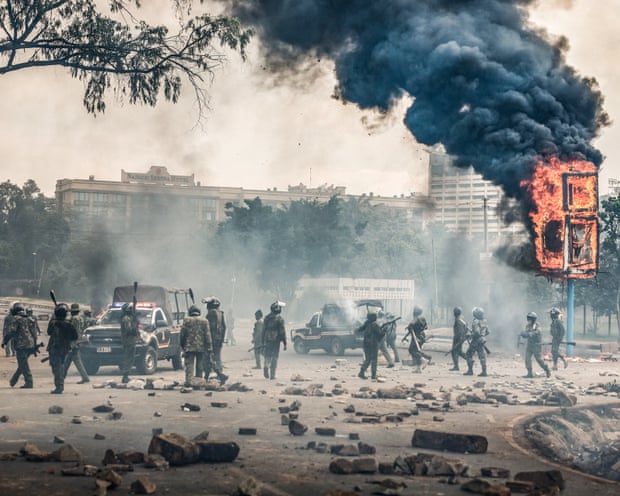 |
| Members of Kenyan security forces gather near a burning city clock in downtown Nairobi. Photograph: Luis Tato/AFP/Getty Images |
I. When a Protest Isn’t Just a Protest
What happened on June 26, 2025, was not a spontaneous demonstration of public frustration. It was the culmination of a deliberate, multi-layered campaign to destabilize the state under the camouflage of civil unrest. Behind the chants of youth and the smoke from burning highways lies a sophisticated architecture of narrative manipulation, institutional betrayal, and strategic collusion.
II. The Pulpit Play: Religious Moral Shielding
On the eve of the riots, key religious figures—most notably Archbishop Anthony Muheria of the Nyeri Diocese—issued public statements urging the state to allow the youth to demonstrate freely. "They are just innocent Kenyans," he claimed. But these words were not innocent.
By granting moral cover just before violence erupted, the Church gave spiritual insulation to what would soon become a coordinated wave of destruction. It disarmed the public's caution and framed state intervention as tyranny, also framed police resistance as "oppression."
III. Cameras for Chaos: Media Complicity & Escalation
Major stations like KTN, K24, and NTV appeared to downplay the chaos while romanticizing the demonstrators. As highways burned, vehicles were torched, businesses looted, and state offices attacked, the broadcasters repeatedly told Kenyans, that the youth were "innocent citizens expressing frustration."
The Communication Authority of Kenya issued a statement accusing these media houses of fanning the flames for content, rewarding riot imagery, and suppressing critical facts. This wasn’t journalism. It was spectacle production.
IV. Judicial Firewalls: Conservatory Orders as Coup Insurance
Immediately after the Communication Authority raised alarm, the Katiba Institute & KNHCR, Law Society of Kenya (LSK), and affiliated media rushed to the High Court. They were met by a familiar figure: Judge Mwita, known for his speedy and often controversial conservatory orders. "This is judicial hijacking in the name of "freedom of expression"—used to stall crisis containment." said Robert Alai, MCA Kileleshwa
Within hours, a court order was issued to block any government action against the media. This judicial firewall allowed the information front of the crisis to operate unchecked. It wasn't the first time, and it won’t be the last unless reformed.
V. Political Subversion: The Real Command Behind the Curtain
Sources reveal this chaos was not grassroots; it was coordinated. Operatives from Central Kenya flooded Githurai, Ruiru, Juja, Kikuyu, and Thika with pre-mobilized gangs. Their targets were not symbolic; they were strategic: Parliament, State House, the Supreme Court. Others were witnessed in areas such as Kitengela, Emali, Matuu, Wote, Nakuru, Ol Kalau and (Kericho, Eldoret - which weren't violent), and a peaceful march which happened in Mombasa and Meru.
The hand behind it all? The camp of the impeached Deputy President, who, alongside new political allies, has been building momentum through tribal appointments, silent radicalization of the police service, and a long game of institutional infiltration.
VI. Commercial Activism: Youth as Political Collateral
Commercial activists and social organizations have repeatedly used vulnerable youth to fuel chaos under the guise of civil movements. On June 26, a harrowing incident was reported: a 26-year-old protester picked up a tear gas canister barehanded. It exploded, injuring him gravely. The response from his handlers? “Bro, tulia utalipwa. Usishike tear gas tena.”
This encapsulates the chilling commodification of youth lives for political optics. They are not activists. They are pawns—sent to the frontlines, sacrificed for narrative gain, and discarded once the cameras stop rolling.
VII. This Wasn’t Civil Disobedience. It Was a Scripted Insurgency.
Religious figures gave it moral fuel. Media houses provided visual amplification. Courts shielded the machinery. And a political faction set the destination. Kenya did not face a protest on June 26th, 2025. It survived an attempted soft coup cloaked in democratic outrage.
Call to Action
“The media cannot be the matchstick. The pulpit cannot be the gasoline. The judiciary cannot be the wind. And still expect the house called Kenya to stand.”
It is time for true patriots—in government, in media, in faith, and in law—to reclaim truth and confront the dangerous actors who weaponize freedom to destroy it.
Kenya Crisis Expose' || A Documentary by The Savvy Journalist
Post a Comment
Let’s connect. Subscribe to my newsletter, follow me on socials, and explore my tools, tips, and real stories from Kenya and beyond.
— Steve, The Savvy Journalist